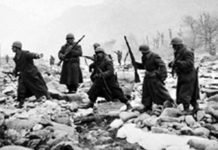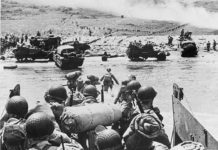
In many ways, the Battle of the Atlantic was a turning point in the war. As long as the Germans continued to have the ability to sink Allied convoys, there remained a real possibility that the Allies would lose the war. [1] Without victory over the U-Boats, D-Day could not have happened. The Battle of the Atlantic, thus, was one of the more important campaigns of the Second World War.
After the war, Churchill paid tribute to this importance by writing:
The Battle of the Atlantic was the dominating factor all throughout the war. Never for one moment could we forget that everything happening elsewhere, on land, at sea, or in the air, depended ultimately on its outcome, and we viewed its changing fortunes day by day with hope or apprehension. [2]
An organization known as Beobachtung Dienst (B-Dienst) caused much of this apprehension. Grand Admiral Karl Dönitz (the Commander-in-Chief of the German Navy and Commander of U-Boat Operations) recalled after the war that it had provided him with half of his operational intelligence. [3] It was the most successful German intelligence organization of the war.
B-Dienst was created in the 1930s as a response to Room 40’s (a predecessor of Bletchey Park) successes during World War I. [4] By 1935, it had been successful enough to penetrate the British navy’s most widely used code. [5] B-Dienst’s work on British naval codes continued to advance throughout the remainder of the 1930s. By September 1939, it had broken the British naval codes so well that the Germans knew the positions of all ships in the British fleet. [6]
In the beginning of the war, B-Dienst had further successes in breaking British codes. The British were slow in responding to this threat, only changing the majority of their naval codes after August 1940. One code that did not change, however, was one that was most useful to the U-Boats: the British and Allied Merchants Ships (BAMS) code. [7] B-Dienst enjoyed a distinct advantage over Bletchey Park as the British were unable to break any German codes until mid-1941.
In 1941, the British Navy made a determined effort to capture Enigma machines or their parts, in order to enable Bletchey Park to break the German naval codes. In February, the Navy raided a trawler in the Arctic Ocean, which yielded spare Enigma wheels. A few months later, two weather reporting ships, the München and the Lauenburg, yielded cipher books. Then in June 1941, U-Boat U-110 was captured during a convoy battle. Before the ship was able to be sunk by the Germans, it was boarded and an Enigma machine was recovered intact. [8]
With these items, Bletchey Park easily broke the German general-purpose naval code Hydra, which was used during 1941 by all U-Boats. [9] This code was being deciphered within an average of 48 hours after it was being received, almost as fast as the Luftwaffe codes. [10] As a result, the average monthly amount of tonnage sunk by U-Boats declined from 282,000 tons between March and June to about 120,000 tons from July to December, a decline of 57 percent. [11] This success, however, did not last long as B-Dienst broke the main British naval cipher (among those changed in August 1940) in September 1941. [12] B-Dienst made a further advance in February 1942 when it cracked the code that was being used by many of the Atlantic convoys. [13] At the same time, Bletchey Park was dealt its most serious setback of the entire war: the changing of the Enigma machine used by U-Boats.
For the next ten months, the British were unable to read the U-Boat Enigma. Coupled with this was the success of B-Dienst in reading the British naval and convoy codes. The results for the Allied convoys was disastrous.
Throughout 1942, the U-Boats sunk over eight million tons of Allied shipping, an increase of more than 80% over 1941 figures. [14] Each month of 1942 saw increased in convoy losses until November, the worst month of the entire war, when 729,160 tons were sunk. [15] And then suddenly, Bletchey Park, through painstaking work, cracked the U-Boat Enigma in December. As a result, convoy losses declined 72% during the next two months from 729,160 tons in November to 203,128 tons in January. [16]
Yet the battle was not over. In March, the machine used by the U-Boats was changed from three wheels to four. The extent of the British nervousness over this was demonstrated by Admiral Edelsten’s (the Admiralty’s Assistant Chief of Staff) note to Admiral Pound (the First Sea Lord) on March 9: “The expected has happened. The Director for Sea Intelligence announced yesterday that information on U-Boat movements is unlikely to be forthcoming for some time – perhaps even months” {emphasis mine} [17]
Partially as a result of this change, the U-Boats sank 627,377 tons in March, a 75% increase over the total for February. [18] Unlike the ten-month gap that was experienced throughout 1942, however, Bletchey Park managed to break the new code by the end of the month. [19] With Ultra back on track, the Allies decided to finally remove the U-Boat threat from the Atlantic.
Until March 1943, Allied strategy mainly focused on maneuvering convoys around the U-Boat peril. Some U-Boats were sunk during the previous two years, but mainly through depth changes and radar, not Ultra. In March 1943, this strategy changed. Many began to believe that it was becoming impossible to maneuver convoys around the U-Boats, as more and more U-Boats were being deployed there. Many agreed with Admiral Pound when he said that “the Atlantic is now becoming so saturated by U-Boats that the practice of evasion is rapidly becoming impossible.” [20] The consensus became that the Allies had “…. to fight the convoys through them.” [21] This became the new Allied strategy, which was crucial in leading to the Allied victory in the Battle of the Atlantic two months later.
Ultra contributed to the new battle strategy. Through Ultra, the Allies knew what convoys were in danger. As a result, they were able to plan accordingly, by organizing “special task forces of escorts” to escort the convoys. [22] All of these changes led to only 327,943 tons sunk during the month of April, a reduction of 48 percent from March. [23]
By the Spring of 1943, “Ultra enabled the Admiralty to play hide-and-seek in the Atlantic with its eyes open.” [24] In May, the Allies sank 47 U-Boats, more than in any more month. [25] These losses proved too much of a burden. On May 24, Dönitz conceded defeat by ordering all of the remaining U-Boats to leave the North Atlantic. [26]
The Battle of the Atlantic was one of the more closely-fought campaigns of the Second World War. In retrospect, it is amazing how close the Germans came to completely thwarting the Allied convoys. The campaign was the only one in which the British did not have an advantage in intelligence. In fact, during much of the battle, the British intelligence efforts were inferior to those of the Germans. Only in the end did the Allies prevail.
During the months of June, July, and August, 96 convoys containing 3,757 ships sailed between the United States and England. Of these, only three were sunk, an infinitesimal percentage. [27] With the ability to ship massive amounts of supplies now assured, the Allies built up supplies and forces for D-Day. Ultra played its greatest role in the planning and execution that followed.
Footnotes:
- [1] Ronald Lewin, Ultra Goes To War, (NY: McGraw-Hill Book Company, 1978), p. 211.
- [2] David Kahn, Hitler’s Spies, (London: Hodder and Stoughton, 1978), p. 219.
- [3] Christopher Andrew and David Dilks, eds., The Missing Dimension, (Southampton, England: Macmillan Publishers, Ltd., 1984), p. 145.
- [4] Lewin, p. 195.
- [5] Kahn, p. 215.
- [6] Ibid., p. 216.
- [7] Lewin, p. 196.
- [8] Peter Calvocoressi, Top Secret Ultra, (Hong Kong, China: Cassell, 1980), p. 86.
- [9] Lewin, pp. 206-207.
- [10] Ibid., p. 209.
- [11] F.H. Hinsley, British Intelligence in the Second World War, v. 2., (London: Her Majesty’s Stationary Office, 1981), p. 169.
- [12] John Winton, Ultra At Sea, (London: Leo Cooper, 1988), p. 103.
- [13] Ibid.
- [14] Calvocoressi, p. 91.
- [15] Winton, p. 109.
- [16] Ibid., p. 114.
- [17] Lewin, p. 217.
- [18] Winton, pp. 114, 131.
- [19] Lewin, p. 217.
- [20] Winton, p. 130.
- [21] Ibid.
- [22] Gerhard L. Weinberg, A World At Arms, (NY: Cambridge University Press, 1995), p. 381.
- [23] Winton, p. 134.
- [24] Calvoressi, p. 91.
- [25] Hinsley, p. 679.
- [26] Lewin, p. 218.
- [27] Ibid., p. 147.







